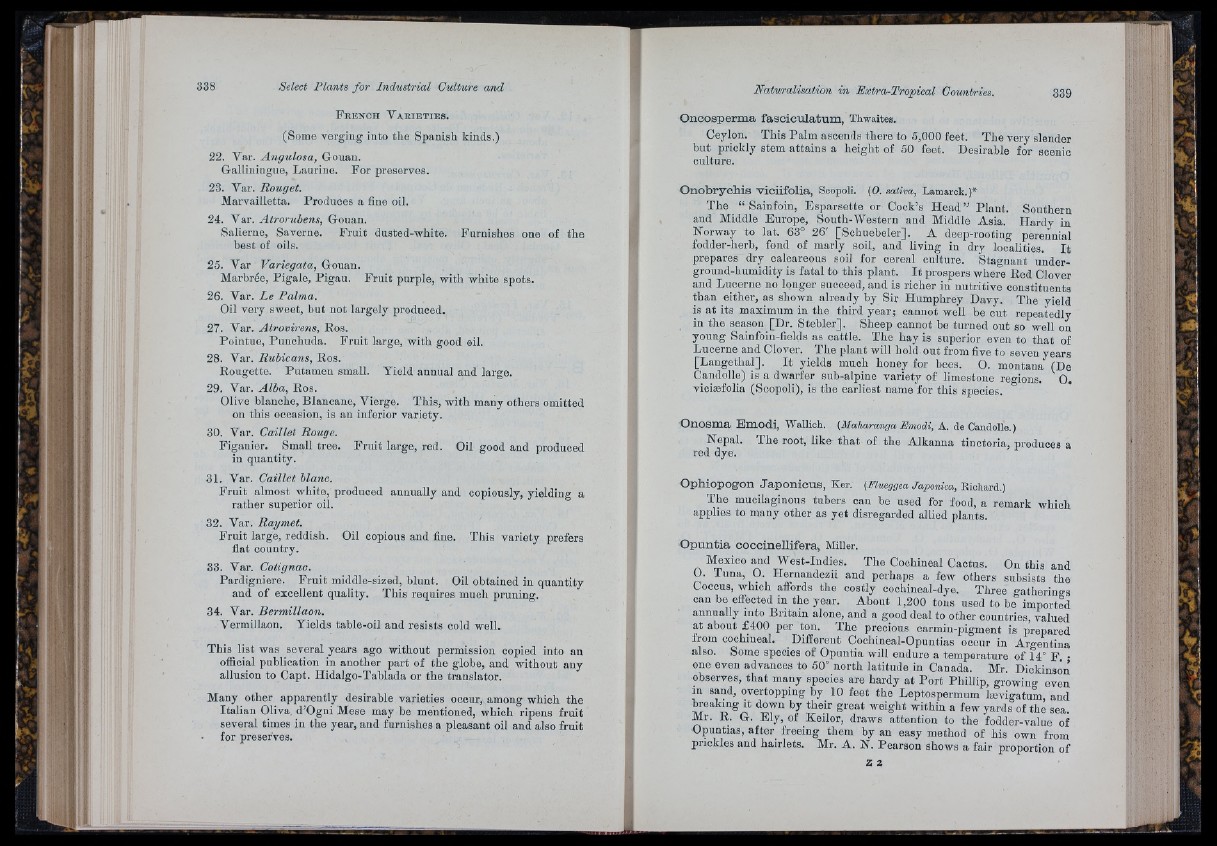
si.
Select Plants fo r Industrial Culture and
F r e n c h V a r i e t i e s .
(Some verging into the Spanish kinds.)
22. Var. Angulosa, Gouan.
Galliningne, Laurine. For preserves.
23. Var. Rouget.
Marvailletta. Produces a fine oil.
24. Var. Atrorubens, Gouan.
Salierne, Saverne. Fruit dusted-white. Furnishes one of the
best of oils.
25. Var Variegata, Gouan.
Marbrée, Pigale, Pigau. Fruit purple, with white spots.
26. Var. Ze Palma.
Oil very sweet, but not largely produced.
27. Var. Atrovirens, Ros.
Pointue, Punchuda. F ru it large, with good oil.
28. Var. Rubicans, Eos.
Rougette. Putamen small. Yield annual and large.
29. Var. Alba, Eos.
Olive blanche, Blanoane, Vierge. This, with many others omitted
on this occasion, is an inferior variety.
30. Var. Caillet Rouge.
Figanier. Small tree. F ru it large, red. Oil good and produced
in quantity.
31. Var. Caillet blanc.
Fruit almost white, produced annually and copiously, yielding a
rather superior oil.
32. Var. Raymet.
F ru it large, reddish. Oil copious aud fine. This variety prefers
flat country.
33. Var. Colignac.
Pardigniere. F ru it middle-sized, blunt. Oil obtained in quantity
and of excellent quality. This requires much pruning.
34. Var. Bermillaon.
Vermillaon. Yields tahle-oil and resists cold well.
This list was several years ago without permission copied into an
official publication in another part of the globe, and without any
allusion to Capt. Hidalgo-Tablada or the translator.
Many other apparently desirable varieties occur, among which the
Italian Oliva d’Ogni Mese may be mentioned, which ripens fruit
several times in the year, and furnishes a pleasant oil and also fruit
for preserves.
Oncosperma fascioulatuin, Thwaites.
Ceylon. This Palm ascends there to 5,000 feet. The very slender
bnt prickly stem attains a height of 50 feet. Desirable for scenic
culture.
Onobrychis viciifolia, Scopoli. (0. sativa, Lamarck.)*
The “ Sainfoin, Esparsette or Cook’s Head ” Plant. Southern
aud Middle Europe, South-Western and Middle Asia. Hardy in
Norway to lat. 63° 26' [Schuebeler]. A deep-rooting perennial
fodder-herb, fond of marly soil, and living in dry localities. I t
prepares dry calcareous soil for cereal culture. Stagnant under-
ground-humidity is fatal to this plant. I t prospers where Red Clover
and Lucerne no longer succeed, and is riclier in nutritive constituents
than either, as shown already by Sir Humphrey Davy. The yield
is a t its maximum in the third year; cannot well be cut repeatedly
in the season [Dr. Stebler]. Sheep cannot be turned out so well on
young Sainfoin-fields as cattle. The hay is superior even to th a t of
Lucerne and Clover. 'The plant will hold out from five to seven years
[Langethal]. I t yields much honey for bees. O. montana (De
Candolle) is a dwarfer sub-alpine variety of limestone regions. 0 .
viciæfolia (Scopoli), is the earliest name for this species.
Onosma Emodi, Wallich. (Maharanga Emodi, A. de Candolle. )
Nepal. 'The root, lik& th a t of the Alkanna tinctoria, produces a
red dye.
Ophiopogon Japonious, Ker. (Elueggea Japónica, Richard.)
'The mucilaginous tubers can be used for food, a remark which
applies to many other as yet disregarded allied plants.
Opuntia ooooinellifera, Miller.
Mexico and West-Indies. The Cochineal Cactus. On this and
q . Tuna, O. Hernandezii aud perhaps a few others subsists the
Coccus, which affords tlie costly cooliiueal-dye. Three gatherings
can be effected in the year. About 1,200 tons used to be im p o rt^
annually into Britain alone, and a good deal to other countries, valued
a t about £400 per ton. 'The precious carmin-pigment is prepared
from cochineal. Different Cochineal-Opuntias occur in Argentina
also. Some species of Opuntia will endure a temperature of 14° F •
one even advances to 50° north latitude in Canada. Mr. Dickinsén’
observes, th a t many species are hardy a t Po rt Phillip, growing even
m sand, overtopping by 10 feet the Leptospermum lævigatum, and
breaking It down by tlieir great weight within a few yards of tlie sea.
Mr. R. G. Ely, of Keilor, draws attention to the fodder-value of
Opuntias, after freeing them by an easy method of his own from
prickles and hairlets. Mr. A. N. Pearson shows a fair proportion of
I i